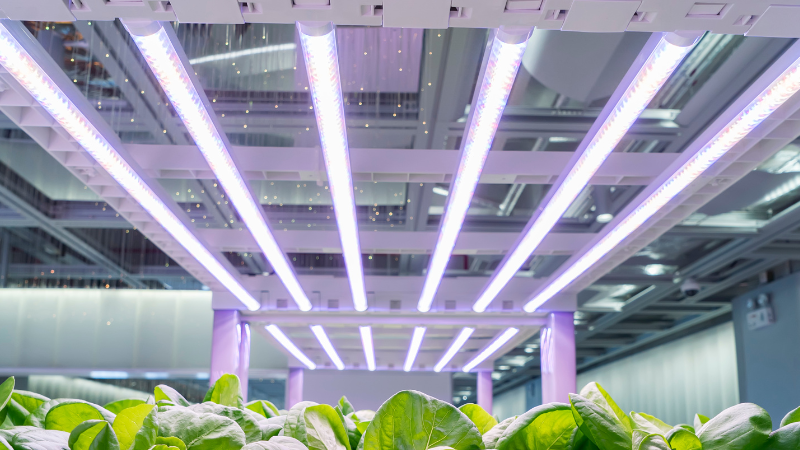When selecting LED products for commercial lighting applications, several factors should be considered to ensure optimal performance, energy efficiency, and cost-effectiveness. These factors can vary depending on the specific needs of the commercial space, such as the type of business, location, lighting requirements, and energy goals. Here are the key factors to keep in mind:
1. Light Output (Lumen Output)
- Required Brightness: The amount of light output required for a space depends on its function (e.g., office, warehouse, retail). For example, office spaces typically need about 300-500 lumens per square meter (lux), while warehouses or industrial spaces might need higher levels of brightness (e.g., 500-1000 lux).
- Color Temperature: LED lights come in different color temperatures measured in Kelvins (K). For commercial settings:
- Warm White (2700-3000K): Suitable for retail stores or restaurants where a warm, inviting ambiance is needed.
- Neutral White (3500-4000K): Ideal for offices, healthcare settings, and general workspaces.
- Cool White (5000-6500K): Best for industrial settings or areas that require high visibility and focus, like warehouses or laboratories.
- Brightness vs. Energy Consumption: Choose LEDs that provide sufficient light output while ensuring they are energy-efficient, so you avoid over-lighting areas and increase cost savings.
2. Energy Efficiency (Wattage and Efficacy)
- Wattage: Lower wattage LEDs with higher lumen output provide better energy efficiency. Compare the wattage of different LED products to ensure you are selecting the most energy-efficient option that meets your lighting needs.
- Luminous Efficacy (Lumens per Watt): This is a measure of how effectively the LED converts electrical power (watts) into light. High efficacy LEDs (e.g., 100 lumens per watt or higher) are preferable because they reduce electricity consumption without compromising brightness.
- Energy Savings: LEDs typically use up to 80% less energy than traditional lighting solutions. By selecting high-efficiency LEDs, you can significantly lower electricity costs over time.
3. Durability and Lifespan
- Longevity: LEDs generally have long lifespans, often between 25,000 to 50,000 hours, depending on the quality of the product. In commercial applications, selecting LEDs with longer lifespans reduces maintenance costs and the need for frequent bulb replacements.
- Maintenance Requirements: Choose LEDs that require minimal maintenance, as reducing downtime for replacement and maintenance is crucial in commercial settings. Opt for products with a good warranty to ensure long-term reliability.
4. Compatibility with Dimming and Controls
- Dimming Capability: Many commercial spaces require adjustable lighting levels for different activities or times of day. Ensure that the selected LED products are compatible with dimming systems (e.g., 0-10V, DALI, or PWM dimming).
- Smart Lighting Integration: Consider LEDs that can be integrated with smart lighting controls, occupancy sensors, and daylight harvesting systems. These technologies allow for automatic adjustments of lighting levels based on occupancy and natural light, contributing to further energy savings and increased comfort.
5. Color Rendering Index (CRI)
- Accuracy of Color Representation: The CRI measures how accurately a light source renders colors compared to natural light. In commercial environments like retail stores, showrooms, or healthcare facilities, selecting LEDs with a high CRI (above 80) can ensure that colors appear vibrant and true to life. For specialized applications, such as in art galleries or photography studios, a CRI of 90 or higher may be necessary.
- Work Environment Considerations: In office settings, CRI values around 80-85 are typically sufficient, while higher CRI values are essential in spaces where color differentiation is crucial.
6. Heat Management and Thermal Performance
- Heat Dissipation: LEDs produce less heat than traditional light sources, but they still need proper heat management to prevent premature failure. Look for products with adequate heat sinks and thermal management features to ensure the LEDs perform well over time, especially in environments with high ambient temperatures (e.g., warehouses).
- Operating Temperature Range: Consider the operating temperature range of the LEDs to ensure they can function optimally in the specific commercial environment. Some LEDs are designed for extreme cold (e.g., refrigerated spaces) or high-heat environments (e.g., industrial settings).
7. Cost of Ownership
- Initial Cost vs. Long-Term Savings: While LEDs often have a higher upfront cost than traditional lighting, their long lifespan, energy efficiency, and lower maintenance costs result in significant savings over time. Consider the total cost of ownership (TCO), including initial installation costs, energy savings, and maintenance savings.
- Return on Investment (ROI): Many businesses experience ROI within 1-2 years due to lower electricity costs and reduced maintenance. Choosing higher-quality, efficient LEDs will maximize these savings and provide a quicker payback.
8. Compliance with Standards and Certifications
- Energy Star Rating: Look for LEDs with certifications such as the Energy Star label, which indicates that the product meets strict energy efficiency and performance standards.
- UL Listing: Ensure the LEDs are UL-listed (or comply with other local safety standards) to confirm their quality and safety for commercial use.
- RoHS Compliance: Ensure the LED products are free from hazardous materials, as indicated by RoHS (Restriction of Hazardous Substances) compliance.
9. Environmental Impact
- Recyclability: LEDs are more environmentally friendly than traditional lighting, but some models may be more sustainable than others. Look for products that use recyclable materials and have minimal environmental impact during production and disposal.
- Low Carbon Footprint: Select LEDs that are produced using sustainable manufacturing processes and contribute to reducing energy consumption and overall carbon emissions in your commercial space.
10. Application-Specific Requirements
- Type of Commercial Space: The type of space where the LEDs will be used can influence the choice of lighting. For instance:
- Retail Stores: LEDs with a high CRI, customizable brightness, and color temperature options to highlight merchandise and create the right ambiance.
- Offices: LEDs with adjustable brightness and color temperature to accommodate various tasks and working hours.
- Warehouses and Factories: High-lumen, durable LEDs with wide light distribution and resistance to rough conditions.
- Healthcare Facilities: High-CRI LEDs with low glare and easy-to-maintain features for patient comfort and diagnostic tasks.
Selecting the right LED products for commercial lighting applications requires a careful balance of energy efficiency, light output, durability, and compatibility with existing systems. By considering factors such as energy savings, color temperature, CRI, lifespan, heat management, and cost-effectiveness, businesses can ensure they choose the best LEDs to meet their specific needs. This not only improves lighting quality and comfort but also supports sustainability goals and reduces long-term operational costs.














